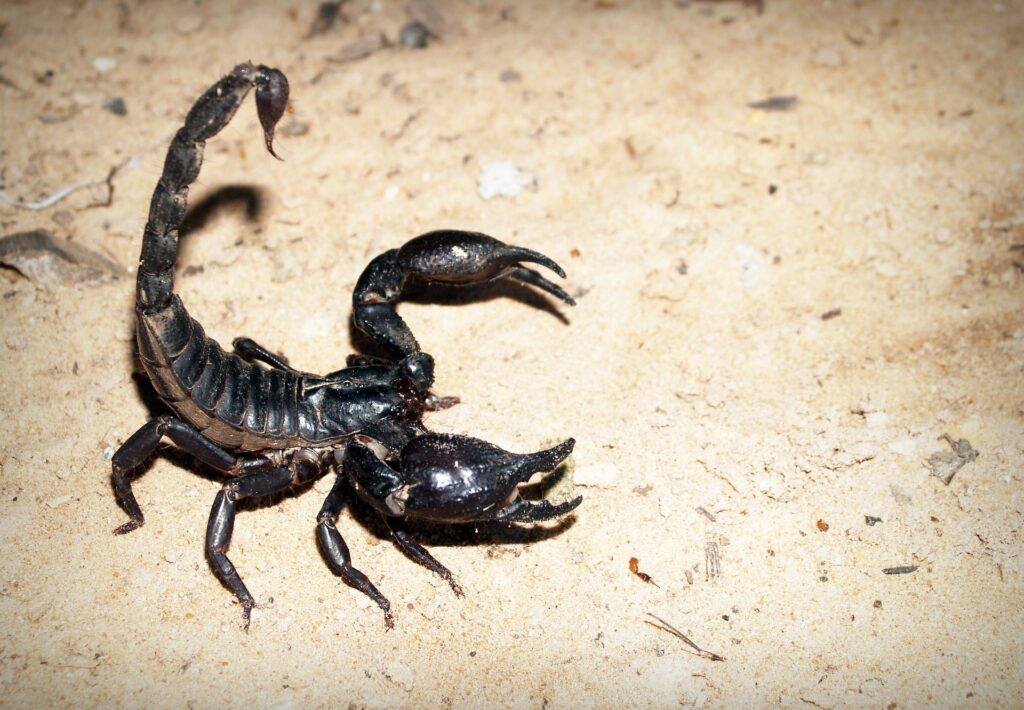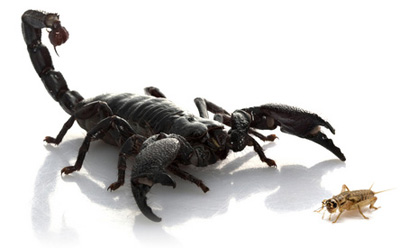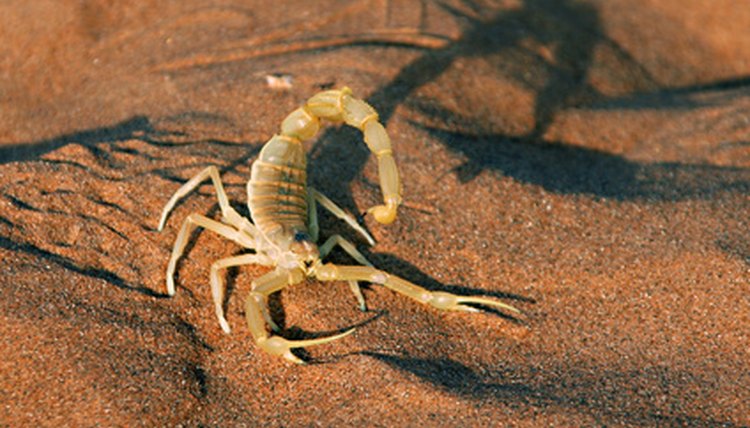HOW TO KEEP A SCORPION AS A PET
A scorpion is a pet you can never hold. He won’t learn to recognize or interact with you, but he will make up for his lack of cuddliness by providing your with hours of fascinating observation. Scorpions are either jungle species or desert species. Since the habitat and care differ for the two types, it’s crucial to know which type of scorpion you have. For beginners, the Amateur Entomologists’ Society recommends large, jungle species such as emperor scorpions (Pandinus imperator), Thai black scorpions (Heterometrus spinifer) and Javanese Jungle scorpions (H. javanensis).
Place a 2- to 4-inch layer of substrate in the bottom of the aquarium. Use clean, chemical-free sand for desert species. Use a finely ground organic substrate covered with a thin layer of coarse bark for jungle species. Mist organic substrates with a fine spray of water until they are moist but not wet.
Add a flat rock or ceramic ornament to give your scorpion a place to hide. Other ornaments aren’t necessary for the scorpion but may add to your enjoyment.
Place a shallow water dish in one corner of the aquarium and keep it full for jungle species. Remove the dish with tongs and wash it thoroughly with soap and water every few days. For desert species, provide a damp piece of natural sponge in the corner of the aquarium. Some species can get all the moisture they need from the air, but if you aren’t sure about your scorpion, it’s best to give him a sponge.
Attach a heat mat to the side of the aquarium with tape. A heat mat designed for use with reptiles is ideal.
Place the container that holds the scorpion inside the aquarium and cover the aquarium with a tight-fitting habitat lid. Secure the lid in place with aquarium lid clips. Remove the container with tongs once the scorpion moves out into the environment.
Mist the substrate in jungle habitats daily. Desert habitats rarely need misting.
Feed the scorpion once or twice a week, at night. Feed small scorpions small crickets, or pinheads. A large scorpion will eat three to five adult crickets per week. Remove uneaten crickets after a few hours. Be aware that uneaten food may indicate illness or improper habitat, so consult your specialist.

Top Scorpion Species Suitable as Pets
Emperor Scorpion
For beginners, the most universally recommended scorpion species to keep as a pet is the emperor scorpion. This scorpion is fairly docile, and the venom of its sting only causes a mild, localized reaction in most people. Some say this scorpion is more likely to try to pinch you with its claws than sting you, but it typically won’t become aggressive unless it feels threatened.
Tanzanian Red-Clawed Scorpion
The Tanzanian red-clawed scorpion is from the same genus as the emperor scorpion, though it is smaller than its popular cousin. It also tends to be more aggressive and willing to sting than the emperor scorpion, so it is not recommended for beginners. But its venom is mild like a bee sting. Red claws can live for around eight years in captivity.
Malaysian Black Scorpion
The Malaysian black scorpion is a large, rainforest-dwelling species that is harder to find as a pet than the emperor scorpion. It also is more aggressive than the emperor scorpion and not ideal for beginners. It’s prone to using its claws rather than stinging for protection. Its venom is mild, just causing localized pain and inflammation in most cases, which is why people still choose to keep it as a pet.
Javanese Jungle Scorpion
Native to rainforests of Indonesia, the Javanese jungle scorpion can live for five to eight years in captivity. But it is fairly aggressive and territorial. These scorpions are most likely to protect themselves with their strong claws, and they also feature a stinger with mild venom. Unlike many other scorpion species, they can be kept in groups, though some might end up fighting.

Food & Diet
Feeding scorpions in captivity is simple. A healthy scorpion will eat almost anything small enough for it to grab.
Gut loaded crickets and mealworms are an ideal source of food. They are readily available at pet stores and online and are inexpensive. Gut loading is the process of keeping the insects well fed so they pass along additional nutrients to your pet.
You should feed your pet every few days to a week. If you have a communal tank make sure you provide enough prey for everyone to eat. If everyone is happy and well fed the chances of fighting or cannibalism is reduced.
The amount of food in the scorpion’s diet should be monitored to ensure a healthy pet. A healthy scorpion is not too skinny or overly fat.
The age of the animal is also a factor in how much it will eat. Young scorpions will eat almost continuously, since they are growing rapidly.
Sometimes a pet will refuse to eat for long periods of time. Do not be alarmed. Healthy adult males have been known to take long fasts lasting months.
A shallow, sturdy water dish should be provided. If you have a communal colony it is a good idea to provide more than one water dish. The dish should be no more than half an inch deep. Fresh water should be provided daily and the bowl cleaned regularly.

Species not recommended for the novice
Hadrurus sp: Hairy Scorpions. A large scorpion (10cm) which does well in the desert setup described above and requires no water (getting all it needs from the atmosphere) – they dislike being misted. They are also considerably more aggressive than Emperor Scorpions with a more potent sting.
Scorpions from the Genus Androctonus are relatively large scorpions from Africa and the Middle East. They are extremely dangerous and care should be taken as some of the larger species (particularly A. bicolor) have a passing resemblance to the Emperor Scorpion – make sure you are confident that your dealer knows exactly what they are selling. Androctonus bicolor have more slender pedipalps (commonly called pincers or claws) than Pandinus imperator and a much thicker tail. Note: Narrow pedipalps on a scorpion often indicate a potent sting.
Bark Scorpions (eg Centruroides and Tityus) should also be avoided by those new to keeping scorpions. Bark scorpions can be recognised as they carry their tail curled to the side of the body rather than arching over the top (ie. the traditional image of scorpions).
What a scorpion habitat requires
Scorpions don’t require a huge amount of space. A ten gallon terrarium should do it. They are fairly small after all, and prefer to spend much of their time burrowed in substrate. You should be aware, however, that these arachnids can squeeze through tiny spaces, climb walls, and lift lids. In other words, your scorpion habitat needs to be secure.
Scorpions are generally safe to keep in groups, but it is possible for a member of the group to be bullied or eaten. If you’re going to keep more than two scorpions, you’ll need a slightly larger terrarium.
Unlike many exotic pets, scorpions do not require UV lighting, but it’s a good idea to put a heat pad under one side of the tank to provide temperature variation. This allows your pet to select the area where the temperature is most comfortable, as well as helping them to regulate their body temperature. Scorpions are most comfortable in an environment around 75 to 90 degrees F. That goes for both desert and jungle species.
The big difference between the two types of scorpions is their substrate requirements. Jungle scorpions require damp substrate and more humidity in their tank (about 80 percent humidity). A glass terrarium makes it easy to maintain the right humidity levels. And peat moss or potting soil are recommended substrates.
Desert scorpions, on the other hand, are fine with dry play sand. For either type of scorpion, you should provide a hide area (or multiple hides if you have multiple scorpions in a habitat).
